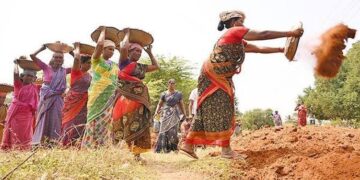There was a time when the golden fields of Kashmir echoed with the rhythmic thud of wooden ploughs and the calloused hands of Kashmiri laborers tilled the earth with an intimate devotion. In the crisp autumn air, they could be seen stacking sheaves of golden paddy, their voices carrying across the fields in songs of toil and triumph. At dawn, they trudged through mist-laden orchards, baskets slung over their shoulders, plucking apples with the same care as one cradles a newborn. They built homes with their own hands, mixed mortar under a watchful gaze, and carried timber across snow-laden passes with unflinching resolve. Hard work was not just a necessity – it was a way of life, a tradition passed down like an heirloom.
And then came spring – the season of renewal, of fresh hopes, of the valley shaking off the last traces of winter’s slumber. This was when the laborers returned to the land, their hands thick with mud, breathing life back into the fields that had lain barren under frost. The clang of sickles in mustard fields, the scent of tilled earth, the sight of men and women bending over saffron corms with the patience of artisans – these were the rituals of spring, marking the eternal bond between Kashmir’s people and its soil. Spring songs like Roshe Wala Myani Dilbaro (Oh, My Rosy Beloved), Harmukh Bartal (Harmukh’s Peak) and many more were heard from a distance. We have killed that Kashmir!
And today, those fields, orchards, and construction sites tell a different story. The hands that once shaped the Valley now rest, while new ones – strong, unyielding, and unfamiliar – have taken their place. The traditional workforce has receded, replaced by the unrelenting industriousness of non-local laborers, especially from Bihar. Has Kashmir lost its will to work? Or has the influx of Bihari and other non-local workers simply exposed a gap that the locals themselves are unwilling to fill?
The Vanishing Kashmiri Laborers
It is an inconvenient but unavoidable truth: over the past two decades, Kashmiri youth have distanced themselves from manual labor. Labor-intensive work is now deemed undesirable, if not outright degrading, by many young Kashmiris who once had no qualms about engaging in such jobs. With a social landscape increasingly shaped by aspirations of white-collar employment, traditional vocations like masonry, carpentry, and farm labor are often looked down upon. And yet, work does not disappear – it simply finds new hands.
A New Backbone for Kashmir’s Economy
The void left by the declining Kashmiri workforce has been filled, almost seamlessly, by an influx of Bihari laborers. These workers, known for their indefatigable spirit and willingness to work under tough conditions, have become indispensable to Kashmir’s economy. From construction sites in Srinagar to apple orchards in Sopore, from laying roads in Budgam to working in brick kilns in Pulwama, their presence is ubiquitous.
Unlike Kashmiri workers, who often demand shorter working hours, higher wages, taelwors, cigarettes, and lunch packs, Bihari laborers are willing to work from dawn till dusk for lower wages. They bring a work ethic that thrives on endurance, savings, and self-reliance. They do not shy away from hardship, and they have no reservations about doing menial jobs that Kashmiris have abandoned.
Over the years, this reliance on non-local labor has increased exponentially. Today, there are thousands of such workers in every district, living in rented accommodations, sending money home, and forming tightly-knit communities that support one another.
A Mini-Bihar in the Making?
The sheer scale of this influx prompts an intriguing question: is Kashmir on the path to developing its own mini-Bihar? Demographically, the possibility cannot be dismissed. Many of these workers, having lived in Kashmir for decades, are now raising families here. Their children are learning Kashmiri, adapting to local customs, and gradually integrating into Kashmiri society. There are already settlements where the Bihari workforce has established permanent roots, especially in peri-urban areas.
Economically, Kashmir’s dependency on non-local workers is reaching a critical point. What happens when the majority of Kashmir’s orchards, construction projects, and handicrafts industries rely on a workforce that is not native? What happens when laborer colonies become permanent, when local Kashmiris become employers rather than workers?
Socially, this could have far-reaching consequences. Will a parallel sub-economy emerge, one where the Bihari workforce operates independently, sending wealth out of Kashmir rather than circulating it within?
The sustained presence and integration of non-local laborers have led to discussions about the potential emergence of a ‘mini-Bihar’ within Kashmir. Culturally, these workers bring their traditions, languages, and lifestyles, contributing to the region’s diversity. Economically, their contribution is indispensable, ensuring the continuity of vital sectors such as agriculture, construction, and services. Over time, as these laborers establish deeper roots, there is a possibility of distinct communities forming.
The Pertinent Questions
The transformation of Kashmir’s labor dynamics is a phenomenon that warrants introspection. Have Kashmiris truly lost the habit of working, or has economic restructuring rendered them unwilling to take up the very jobs that sustained their ancestors? And if this trend continues, how will it reshape the Valley’s social, economic, and cultural landscape in the coming decades?
One thing is certain: the tide is shifting. And in this tide, Kashmir stands at a crossroads – either to reclaim its lost labor ethos or to embrace the inevitable evolution of a workforce that is no longer solely its own.
Kashmir Employment and Labour Data
| Category | Value |
|---|---|
| Urban Youth Unemployment Rate (15-29 years) | 32% |
| Female Unemployment Rate | 53.6% |
| Estimated Non-Local Labourers | 500,000 – 1,000,000 |
| Average Daily Wage (Rs) | 700 |
| Estimated Working Days Per Year | 225 |
| Total Annual Earnings of Non-Local Labourers (Rs Crores) | 7,875 |
The Startling Figures
While precise, up-to-date figures are challenging to ascertain, various estimates suggest that the number of non-local laborers in Jammu and Kashmir ranges between 500,000 to 1,000,000. These workers typically arrive in early spring and remain until late autumn, capitalizing on the peak agricultural and construction seasons.
The financial implications of this labor migration are profound. Assuming an average daily wage of Rs700 across various skill levels and an estimated 225 working days per year (accounting for seasonal breaks and unforeseen disruptions), a conservative estimate for 500,000 migrant laborers would result in annual earnings of approximately Rs78.75 billion (Rs7,875 crores). This figure underscores the substantial economic role these workers play in Kashmir’s economy.




